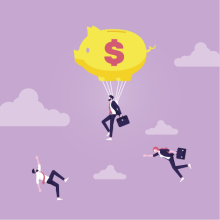A Soft Landing?
If you’re wondering why the markets have been rallying lately, it is likely because market participants are beginning to believe that it is possible we will have a soft landing for the economy. A soft landing is essentially bringing economic growth down while avoiding a difficult recession. I think the jury is still out on this scenario, but this seems to be why the market is rallying.
We tend to be a bit more cautious than this optimistic perspective, but we do believe it is a possibility. The labor market continues to be strong despite difficult inflation. How the drop in home prices will affect inflation in the economy is a wild card; home equity is a large part of what funds strong economic growth.
The article below goes into significant detail regarding what the definition of soft landing is. I think you’ll find it interesting.
***
Begin Quote
“What Is a Soft Landing?
A soft landing, in economics, is a cyclical slowdown in economic growth that avoids recession. A soft landing is the goal of a central bank when it seeks to raise interest rates just enough to stop an economy from overheating and experiencing high inflation, without causing a severe downturn. Soft landing may also refer to a gradual, relatively painless slowdown in a particular industry or economic sector.
Understanding Soft Landings
While airline passengers can take soft landings for granted these days, the Federal Reserve's past interest-rate hiking cycles don't have the same track record of regular success.
The term "soft landing" gained currency during the tenure of former Federal Reserve chair Alan Greenspan, widely credited with engineering one in 1994-1995. Federal Reserve Chair Jerome Powell has also suggested the Fed achieved soft landings in 1965 and 1984 and was on course for another one in 2020 before the COVID-19 pandemic intervened.
In contrast, a recession followed the last five instances when inflation peaked above 5%, in 1970, 1974, 1980, 1990, and 2008. Inflation has gone above 5% in 2022, and given the definition of a recession (two consecutive quarters of negative GDP growth), which occurred after Q1 and Q2 of 2022, the economy was in a recession; however, Q3 saw GDP growth.
To combat this inflation, the Fed implemented interest rate increases over the year, which resulted in a decrease in inflation combined with economic growth in Q3.
Special Considerations
The Fed's soft landings record is, at best, mixed because the central bank doesn't exercise nearly the same control over the course of the economy as a pilot has over aircraft. The Fed's main policy tools—interest rates and asset holdings—are blunt instruments not designed to solve supply chain disruptions or pandemics.
In dismissing another vehicular analogy, former Fed chair Ben Bernanke once said that "if making monetary policy is like driving a car, then the car is one that has an unreliable speedometer, a foggy windshield, and a tendency to respond unpredictably and with a delay to the accelerator or the brake." Nothing that's happened since has made the Fed's job look any easier.
What Is a Soft Landing vs. a Hard Landing in Economics?
A country's central bank adjusts interest rates to manage the economy. If inflation is too high, a central bank will increase interest rates with the goal of slowing down spending. If the central bank raises interest rates too high or too soon, that would be a hard landing. If the central bank raises interests slowly or by a small amount, that is a soft landing. There is a fine line between the two and how the raising of interest rates will impact the economy. A central bank would not want a hard landing as it could have serious negative repercussions.
What Are the Main Causes of Inflation?
The main causes of inflation are demand-pull inflation (when the demand for goods and services is greater than the supply to meet that demand), cost-push inflation (the increase in prices due to the increase in prices of raw materials and labor), an increase in the money supply, rising wages, and a devaluation of a nation's currency.
What Are the Components of Monetary Policy?
A country's central bank has three primary tools to control its monetary policy. These are controlling the reserve requirements of banks, adjusting the discount rate (the interest rate charged to financial institutions when borrowing from the central bank), and open market operations (the buying and selling of securities).
The Bottom Line
The Fed's attempts to bring about a soft landing are complicated by the policy lags Bernanke and many others have noted. Because the economy takes time to respond to changes in monetary policy, the Fed must determine the pace of rate hikes without the benefit of seeing the full effect of prior ones, or of its policy signaling.
For signaling to have an effect, the Fed's policy must be seen as at least somewhat predictable, limiting the central bank's flexibility in responding to economic developments. Such constraints mean luck still plays at least as big a role as skill when it comes to soft economic landings.”
End Quote
Source: https://www.investopedia.com/terms/s/softlanding.asp
***


